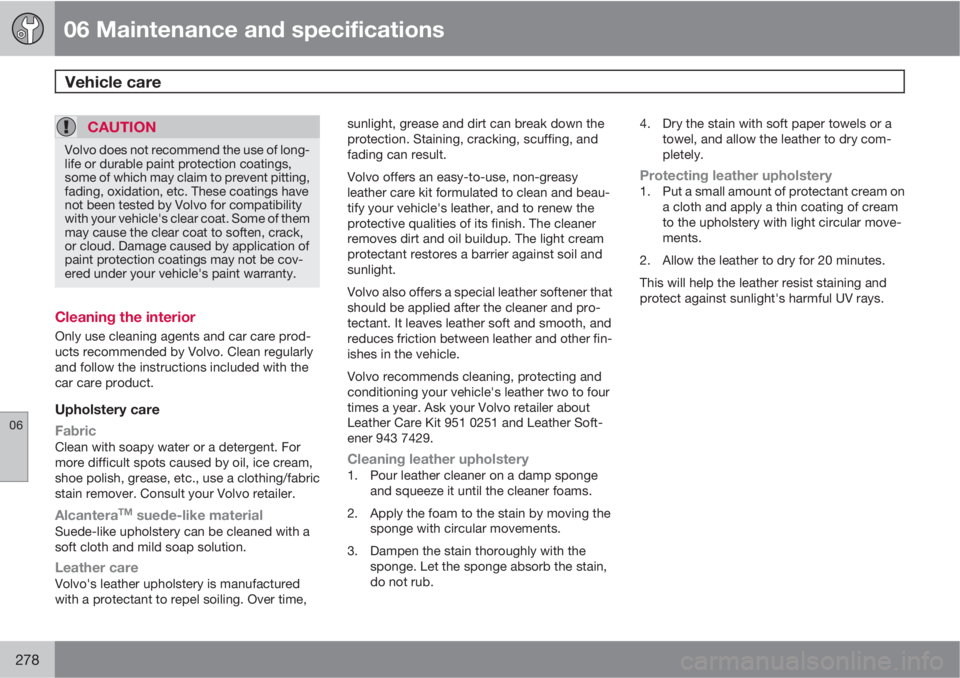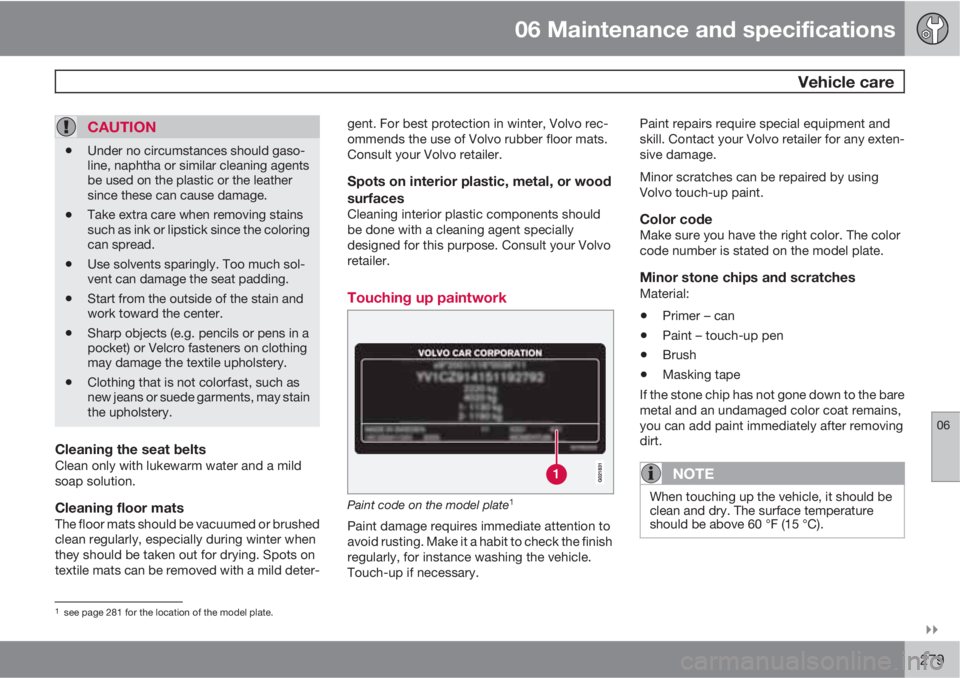Page 277 of 302

06 Maintenance and specifications
Vehicle care
06
��
277
CAUTION
•Avoid waxing or polishing plastic or rub-
ber components
•Polishing chromed strips can wear
away or damage the surface
•Polishes containing abrasive sub-
stances should not be used
Automatic car wash
•We do NOT recommend washing your car
in an automatic wash during the first six
months (because the paint will not have
hardened sufficiently).
•An automatic wash is a simple and quick
way to clean your car, but it is worth
remembering that it may not be as thor-
ough as when you yourself go over the car
with sponge and water. Keeping the under-
body clean is most important, especially in
the winter. Some automatic washers do
not have facilities for washing the under-
body.
CAUTION
•Before driving into an automatic car
wash, turn off the optional rain sensor to
avoid damaging the windshield wipers.
•Make sure that side view mirrors, auxil-
iary lamps, etc, are secure, and that any
antenna(s) are retracted or removed.
Otherwise there is risk of the machine
dislodging them.
•Chromed wheels: Clean chrome-
plated wheels using the same deter-
gents used for the body of the vehicle.
Aggressive wheel-cleaning agents can
permanently stain chrome-plated
wheels.
WARNING
•When the vehicle is driven immediately
after being washed, apply the brakes,
including the parking brake, several
times in order to remove any moisture
from the brake linings.
•Engine cleaning agents should not be
used when the engine is warm. This
constitutes a fire risk.
Exterior lightingCondensation may form temporarily on the
inside of the lenses of exterior lights such as
headlights, fog lights, or taillights. This is nor-mal and the lights are designed to withstand
moisture. Normally, condensation will dissi-
pate after the lights have been on for a short
time.
Polishing and waxing
•Normally, polishing is not required during
the first year after delivery, however, wax-
ing may be beneficial.
•Before applying polish or wax the vehicle
must be washed and dried. Tar spots can
be removed with kerosene or tar remover.
Difficult spots may require a fine rubbing
compound.
•After polishing use liquid or paste wax.
•Several commercially available products
contain both polish and wax.
•Waxing alone does not substitute for pol-
ishing a dull surface.
•A wide range of polymer-based waxes can
be purchased today. These waxes are easy
to use and produce a long-lasting, high-
gloss finish that protects the bodywork
against oxidation, road dirt and fading.
•Do not polish or wax your vehicle in direct
sunlight (the surface of the vehicle should
not be warmer than 113 °F (45 °C).
Page 278 of 302

06 Maintenance and specifications
Vehicle care
06
278
CAUTION
Volvo does not recommend the use of long-
life or durable paint protection coatings,
some of which may claim to prevent pitting,
fading, oxidation, etc. These coatings have
not been tested by Volvo for compatibility
with your vehicle's clear coat. Some of them
may cause the clear coat to soften, crack,
or cloud. Damage caused by application of
paint protection coatings may not be cov-
ered under your vehicle's paint warranty.
Cleaning the interior
Only use cleaning agents and car care prod-
ucts recommended by Volvo. Clean regularly
and follow the instructions included with the
car care product.
Upholstery care
Fabric
Clean with soapy water or a detergent. For
more difficult spots caused by oil, ice cream,
shoe polish, grease, etc., use a clothing/fabric
stain remover. Consult your Volvo retailer.
AlcanteraTM suede-like materialSuede-like upholstery can be cleaned with a
soft cloth and mild soap solution.
Leather careVolvo's leather upholstery is manufactured
with a protectant to repel soiling. Over time,sunlight, grease and dirt can break down the
protection. Staining, cracking, scuffing, and
fading can result.
Volvo offers an easy-to-use, non-greasy
leather care kit formulated to clean and beau-
tify your vehicle's leather, and to renew the
protective qualities of its finish. The cleaner
removes dirt and oil buildup. The light cream
protectant restores a barrier against soil and
sunlight.
Volvo also offers a special leather softener that
should be applied after the cleaner and pro-
tectant. It leaves leather soft and smooth, and
reduces friction between leather and other fin-
ishes in the vehicle.
Volvo recommends cleaning, protecting and
conditioning your vehicle's leather two to four
times a year. Ask your Volvo retailer about
Leather Care Kit 951 0251 and Leather Soft-
ener 943 7429.
Cleaning leather upholstery1. Pour leather cleaner on a damp sponge
and squeeze it until the cleaner foams.
2. Apply the foam to the stain by moving the
sponge with circular movements.
3. Dampen the stain thoroughly with the
sponge. Let the sponge absorb the stain,
do not rub.4. Dry the stain with soft paper towels or a
towel, and allow the leather to dry com-
pletely.
Protecting leather upholstery1. Put a small amount of protectant cream on
a cloth and apply a thin coating of cream
to the upholstery with light circular move-
ments.
2. Allow the leather to dry for 20 minutes.
This will help the leather resist staining and
protect against sunlight's harmful UV rays.
Page 279 of 302

06 Maintenance and specifications
Vehicle care
06
��
279
CAUTION
•Under no circumstances should gaso-
line, naphtha or similar cleaning agents
be used on the plastic or the leather
since these can cause damage.
•Take extra care when removing stains
such as ink or lipstick since the coloring
can spread.
•Use solvents sparingly. Too much sol-
vent can damage the seat padding.
•Start from the outside of the stain and
work toward the center.
•Sharp objects (e.g. pencils or pens in a
pocket) or Velcro fasteners on clothing
may damage the textile upholstery.
•Clothing that is not colorfast, such as
new jeans or suede garments, may stain
the upholstery.
Cleaning the seat beltsClean only with lukewarm water and a mild
soap solution.
Cleaning floor matsThe floor mats should be vacuumed or brushed
clean regularly, especially during winter when
they should be taken out for drying. Spots on
textile mats can be removed with a mild deter-gent. For best protection in winter, Volvo rec-
ommends the use of Volvo rubber floor mats.
Consult your Volvo retailer.
Spots on interior plastic, metal, or wood
surfaces
Cleaning interior plastic components should
be done with a cleaning agent specially
designed for this purpose. Consult your Volvo
retailer.
Touching up paintwork
Paint code on the model plate1
Paint damage requires immediate attention to
avoid rusting. Make it a habit to check the finish
regularly, for instance washing the vehicle.
Touch-up if necessary.Paint repairs require special equipment and
skill. Contact your Volvo retailer for any exten-
sive damage.
Minor scratches can be repaired by using
Volvo touch-up paint.
Color codeMake sure you have the right color. The color
code number is stated on the model plate.
Minor stone chips and scratchesMaterial:
•Primer – can
•Paint – touch-up pen
•Brush
•Masking tape
If the stone chip has not gone down to the bare
metal and an undamaged color coat remains,
you can add paint immediately after removing
dirt.
NOTE
When touching up the vehicle, it should be
clean and dry. The surface temperature
should be above 60 °F (15 °C).
1see page 281 for the location of the model plate.
Page 280 of 302
06 Maintenance and specifications
Vehicle care
06
280
Minor scratches on the surfaceIf the stone chip has not penetrated down to
the metal and an undamaged layer of paint
remains, the touch-up paint can be applied as
soon as the spot has been cleaned.
Repairing stone chips
G021832
1. Place a strip of masking tape over the dam-
aged surface. Pull the tape off so that any
loose flakes of paint adhere to it.
2. Thoroughly mix the primer and apply it with
a small brush.
3. When the primer surface is dry, the paint
can be applied using a brush. Mix the paint
thoroughly; apply several thin paint coats
and let dry after each application.4. If there is a longer scratch, you may want
to protect surrounding paint by masking it
off
5. After a few days, polish the touched-up
areas. Use a soft rag and a small amount
of polish.
Page 281 of 302
06 Maintenance and specifications
Label information
06
��
281 Location of labels
Page 282 of 302

06 Maintenance and specifications
Label information
06
282
List of labels
Model
plate. Vehicle Identification Number (VIN).
Codes for color and upholstery, etc.
Federal Motor Vehicle Safety Standards
(FMVSS) specifications (USA) and Min-
istry of Transport (CMVSS) standards
(Canada). Your Volvo is designed to meet
all applicable safety standards, as evi-
denced by the certification label on the
driver's side B-pillar (the structural mem-
ber at the side of the vehicle, at the rear of
the driver's door opening). For further infor-
mation regarding these regulations, please
consult your Volvo retailer.
Loads and Tire
Pressures. The appearance of the decal
will vary, depending on the market for
which the vehicle is intended. See also
page 257.
Vehicle Identification Number
(VIN). The VIN plate is located on the top
left surface of the dashboard. The Vehicle
Identification Number (VIN) should always
be quoted in all correspondence concern-
ing your vehicle with the retailer and when
ordering parts.
Vehicle Emission Control Information.
Your Volvo is designed to meet all appli-
cable emission standards, as evidenced by
the certification label on the underside of
the hood. For further information regarding
these regulations, please consult your
Volvo retailer.
Page 283 of 302
06 Maintenance and specifications
Specifications
06
��
283 Dimensions
DimensionIn. (mm)
AWheelbase109.2 (2774)
BLength182.2 (4628)
CLoad length, floor, seatback down70.4 (1789)
DLoad length, floor38.3 (972)
EHeight67.4 (1713)
FLoad height31.6 (802)
GTrack, front64.3 (1632)
Page 284 of 302
06 Maintenance and specifications
Specifications
06
284
DimensionIn. (mm)
HTrack, rear62.4 (1586)
ILoad width, floor42.9 (1090)
JWidth74.4 (1891)
KWidth, incl. door mirrors84.3 (2142)
Weights
CategoryUSACanada
Gross vehicle weight6-cyl. FWDA: 5200 lbs
6-cyl. AWD
B: 5355 lbs
6-cyl. turbo AWD: 5380 lbs
-
6-cyl. AWD:2430 kg
6-cyl. turbo AWD:2440 kg
Capacity weight950 lbs (all models)430 kg (all models
Permissible axle weights, front6-cyl. FWD: 2740 lbs
6-cyl. AWD: 2800 lbs
6-cyl. turbo AWD: 2840 lbs-
6-cyl. AWD:1270 kg
6-cyl. turbo AWD:1290 kg
Permissible axle weights, rear6-cyl. FWD: 2545 lbs
6-cyl. AWD: 2640 lbs
6-cyl. turbo AWD: 2645 lbs-
6-cyl. AWD:1200 kg
6-cyl. turbo AWD:1200 kg
Curb weight3920 – 4140 lbs1770 – 1900 kg
Max. roof load220 lbs100 kg